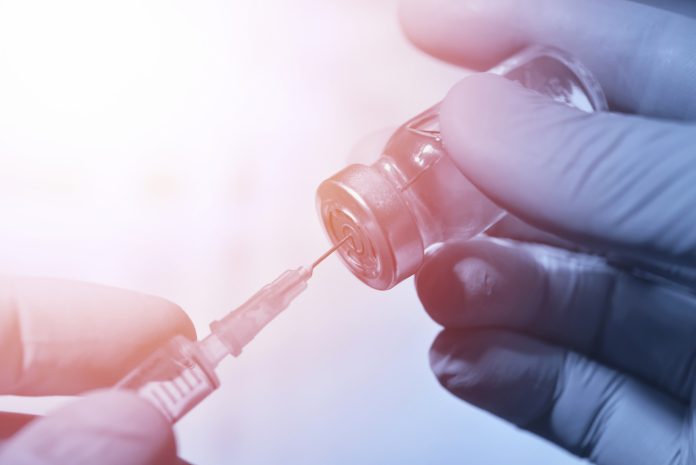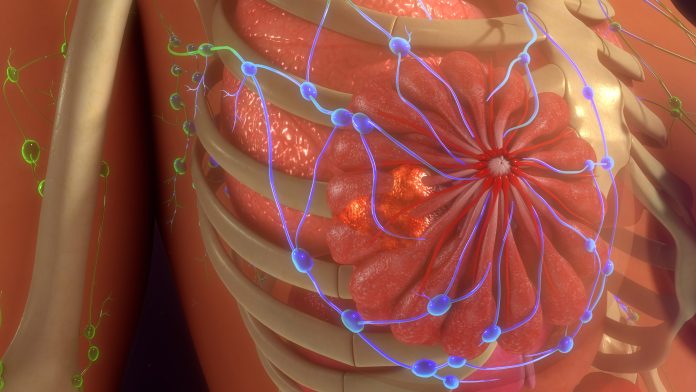
Researchers from the International Institute for Nanotechnology (IIN) at Northwestern University have combined chemistry and nanotechnology to change the structural location of adjuvants and antigens on and within a nanoscale cancer vaccine to boost potency and performance. Their method was published recently in Nature Biomedical Engineering.
“Cancer vaccines must activate multiple immune cell types to be effective against aggressive tumors,” wrote the researchers. “Here we report the impact of the structural presentation of two antigenic peptides on immune responses at the transcriptomic, cellular, and organismal levels. We used spherical nucleic acid (SNA) nanoparticles to investigate how the spatial distribution and placement of two antigen classes affect antigen processing, cytokine production, and the induction of memory.”
“The work shows that vaccine structure and not just the components is a critical factor in determining vaccine efficacy,” explained lead investigator Chad A. Mirkin, PhD, director of the IIN. “Where and how we position the antigens and adjuvant within a single architecture markedly changes how the immune system recognizes and processes it.”
Mirkin and his team studied the effect of vaccine structure in the context of seven different types of cancer to date, including triple-negative breast cancer, papillomavirus-induced cervical cancer, melanoma, colon cancer, and prostate cancer.
“A challenge with conventional vaccines is that out of that blended mish mosh, an immune cell might pick up 50 antigens and one adjuvant or one antigen and 50 adjuvants,” said study author and former Northwestern postdoctoral associate Michelle Teplensky, PhD, who is now an assistant professor at Boston University. “But there must be an optimum ratio of each that would maximize the vaccine’s effectiveness.”
The researchers turned to SNAs (spherical nucleic acids), which are the structural platform used in this new class of modular vaccines. SNAs allow scientists to pinpoint exactly how many antigens and adjuvants are being delivered to cells.
“Vaccines developed through rational vaccinology deliver the precise dose of antigen and adjuvant to every immune cell, so they are all equally primed to attack cancer cells,” said Mirkin. “If your immune cells are soldiers, a traditional vaccine leaves some unarmed; our vaccine arms them all with a powerful weapon with which to kill cancer. Which immune cell ‘soldiers’ do you want to attack your cancer cells?” Mirkin asked rhetorically.
The team developed a cancer vaccine that doubled the number of cancer antigen-specific T cells and increased the activation of these cells by 30% by reconfiguring the architecture of the vaccine to contain multiple targets to help the immune system find tumor cells.
The team investigated differences in how well two antigens were recognized by the immune system depending on their placement of the SNA structure. They also studied how the different placements affected the immune system’s ability to remember the invader, and whether the memory was long-term.
“Where and how we position the antigens and adjuvant within a single architecture markedly changes how the immune system recognizes and processes it,” Mirkin said.
The study data revealed that attaching two different antigens to an SNA comprising a shell of adjuvant was the most potent approach for a cancer vaccine structure. It led to a 30% increase in antigen-specific T-cell activation and doubled the number of proliferating T cells compared to a structure in which the same two antigens were attached to two separate SNAs.
“It is remarkable,” Mirkin said. “When altering the placement of antigens in two vaccines that are nearly identical from a compositional standpoint, the treatment benefit against tumors is dramatically changed. One vaccine is potent and useful, while the other is much less effective.”
“The collective importance of this work is that it lays the foundation for developing the most effective forms of vaccine for almost any type of cancer,” Teplensky said. “It is about redefining how we develop vaccines across the board, including ones for infectious diseases.”
“The developments made in this work provide a path forward to rethinking the design of vaccines for cancer and other diseases as a whole,” Mirkin concluded.










![Best Weight Loss Supplements [2022-23] New Reports!](https://technologytangle.com/wp-content/uploads/2022/12/p1-1170962-1670840878.png)




